
Concept explainers
Specialty Toys
Specialty Toys, Inc., sells a variety of new and innovative children’s toys. Management learned that the preholiday season is the best time to introduce a new toy, because many families use this time to look for new ideas for December holiday gifts. When Specialty discovers a new toy with good market potential, it chooses an October market entry date.
In order to get toys in its stores by October, Specialty places one-time orders with its manufacturers in June or July of each year. Demand for children’s toys can be highly volatile. If a new toy catches on, a sense of shortage in the marketplace often increases the demand to high levels and large profits can be realized. However, new toys can also flop, leaving Specialty stuck with high levels of inventory that must be sold at reduced prices. The most important question the company faces is deciding how many units of a new toy should be purchased to meet anticipated sales demand. If too few are purchased, sales will be lost; if too many are purchased, profits will be reduced because of low prices realized in clearance sales.
For the coming season, Specialty plans to introduce a new product called Weather Teddy. This variation of a talking teddy bear is made by a company in Taiwan. When a child presses Teddy’s hand, the bear begins to talk. A built-in barometer selects one of five responses that predict the weather conditions. The responses
As with other products, Specialty faces the decision of how many Weather Teddy units to order for the coming holiday season. Members of the management team suggested order quantities of 15,000, 18,000, 24,000, or 28,000 units. The wide range of order quantities suggested indicates considerable disagreement concerning the market potential. The product management team asks you for an analysis of the stock-out probabilities for various order quantities, an estimate of the profit potential, and to help make an order quantity recommendation. Specialty expects to sell Weather Teddy for $24 based on a cost of $16 per unit. If inventory remains after the holiday season, Specialty will sell all surplus inventory for $5 per unit. After reviewing the sales history of similar products, Specialty’s senior sales forecaster predicted an expected demand of 20,000 units with a .95
Prepare a managerial report that addresses the following issues and recommends an order quantity for the Weather Teddy product.
- 1. Use the sales forecaster’s prediction to describe a
normal probability distribution that can be used to approximate the demand distribution. Sketch the distribution and show its mean and standard deviation. - 2. Compute the probability of a stock-out for the order quantities suggested by members of the management team.
- 3. Compute the projected profit for the order quantities suggested by the management team under three scenarios: worst case in which sales = 10,000 units, most likely case in which sales = 20,000 units, and best case in which sales = 30,000 units.
- 4. One of Specialty’s managers felt that the profit potential was so great that the order quantity should have a 70% chance of meeting demand and only a 30% chance of any stock-outs. What quantity would be ordered under this policy, and what is the projected profit under the three sales scenarios?
- 5. Provide your own recommendation for an order quantity and note the associated profit projections. Provide a rationale for your recommendation.
1.
Describe a normal probability distribution that can be used to approximate the demand distribution using the sales forecaster’s prediction.
Sketch the distribution and show its mean and standard deviation.
Answer to Problem 1CP
The normal distribution with a mean of 20,000 and a standard deviation of 5,102 can be used to approximate the demand distribution using the sales forecaster’s prediction.
The normal probability distribution that can be used to approximate the demand distribution is shown below:
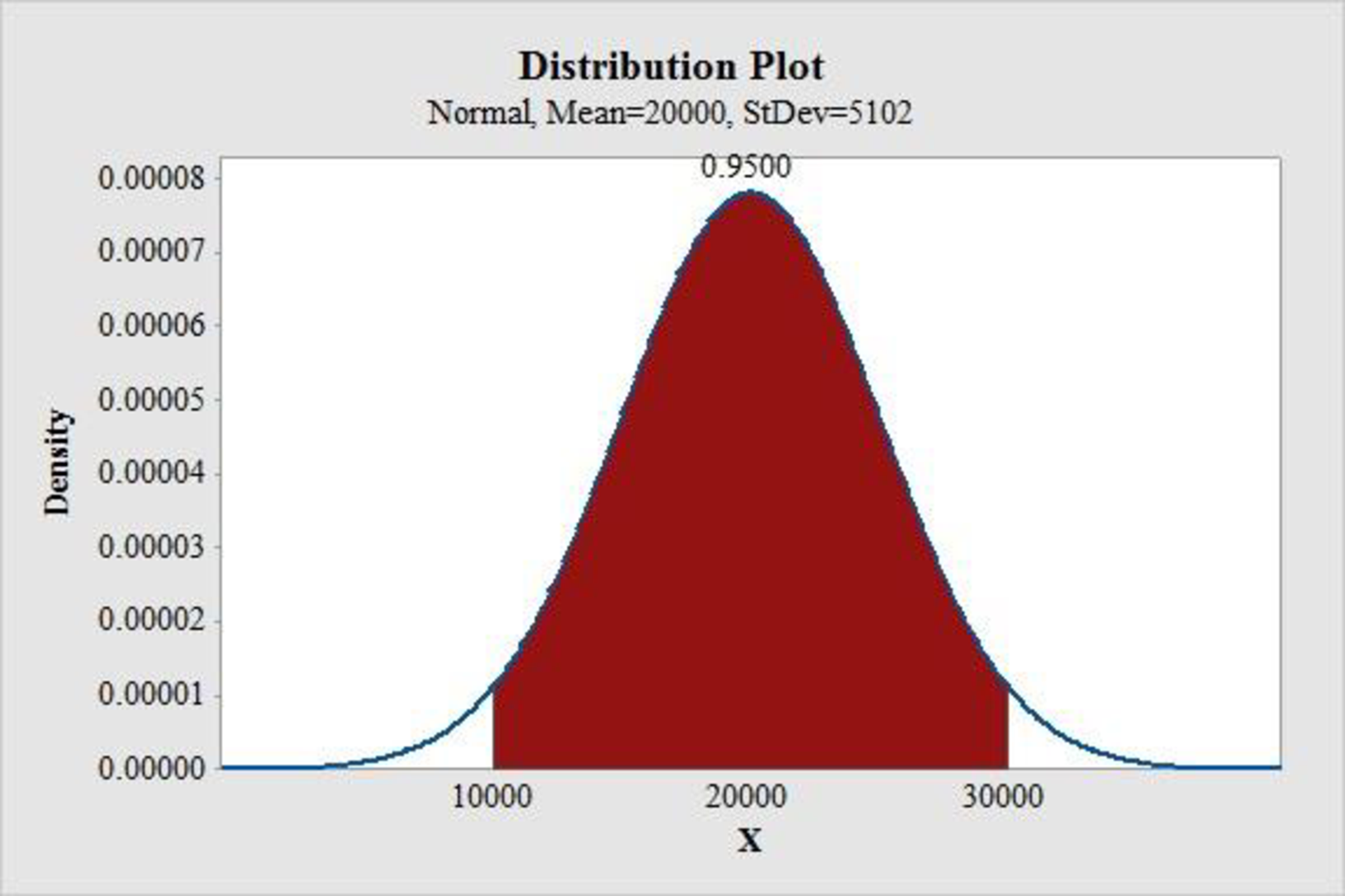
Figure (1)
Explanation of Solution
Calculation:
The order quantities suggested are 15,000, 18,000, 24,000 or 28,000 units. The Weather Teddy is expected to be sold at $24 based on a cost of $16 per unit. All surplus inventories are sold at a cost of $5 per unit. The sales forecaster’s predicted that there will be an expected demand of 20,000 units with a 0.95 probability that demand would be between 10,000 units and 30,000 units.
Define the random variable x as the demand.
From the information provided by the forecaster, demand would be between 10,000 units and 30,000 units with a 0.95 probability.
Software Procedure:
Step-by-step procedure to obtain the z-values using the MINITAB software:
- Choose Graph > Probability Distribution Plot.
- Choose View Probability > OK.
- From Distribution, choose ‘Normal’ distribution.
- Enter the Mean as 0 and Standard deviation as 1.
- Click the Shaded Area tab.
- Choose Probability and Both Tails for the region of the curve to shade.
- Enter the Probability value as 0.05.
- Click OK.
Output using the MINITAB software is given below:
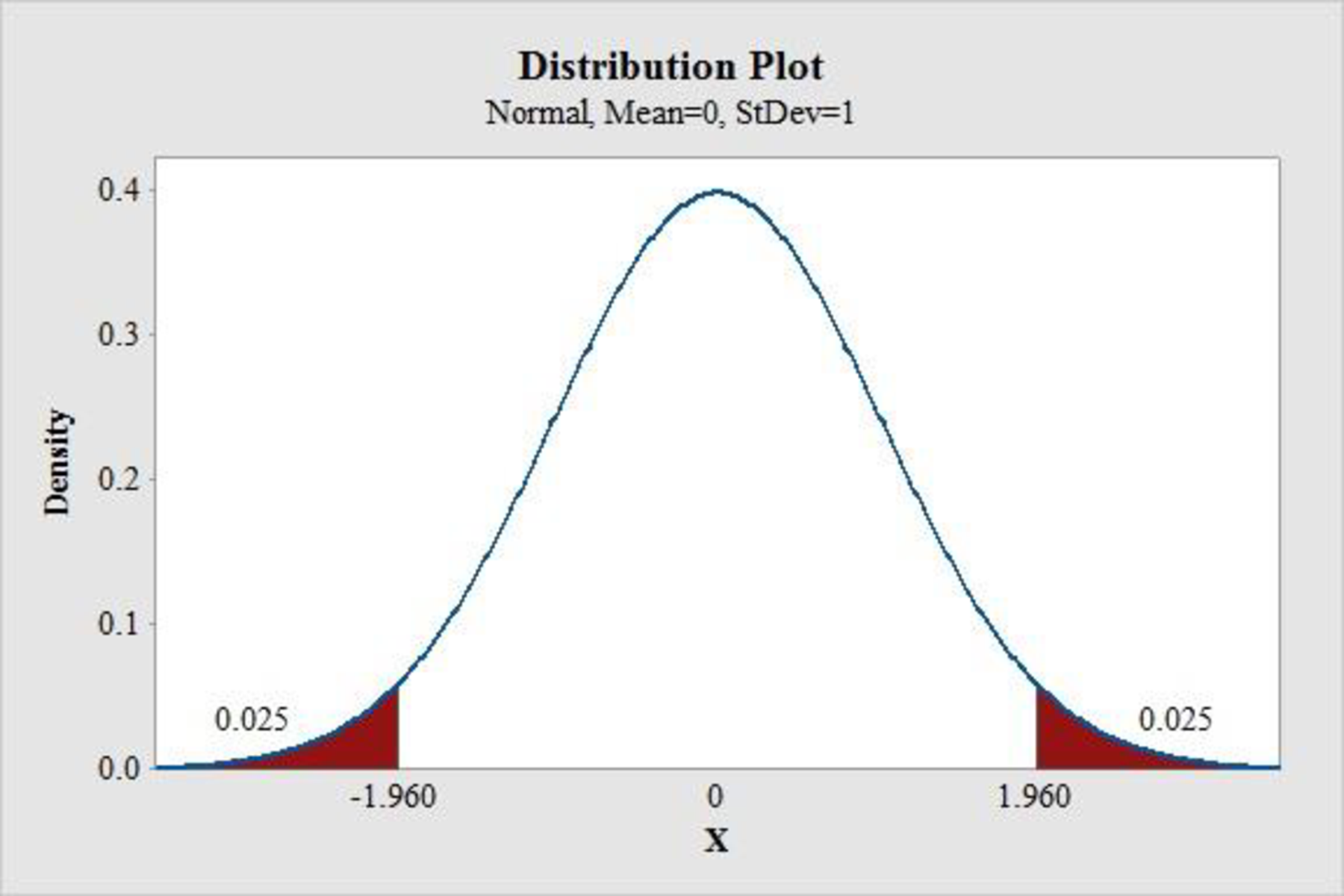
From the MINITAB output the z-values are –1.96 and 1.96.
The formula for z-score is,
At
Thus, the normal distribution with a mean of 20,000 and a standard deviation of 5,102 can be used to approximate the demand distribution using the sales forecaster’s prediction.
Software Procedure:
Step-by-step procedure to draw the normal curve using the MINITAB software:
- Choose Graph > Probability Distribution Plot.
- Choose View Probability > OK.
- From Distribution, choose ‘Normal’ distribution.
- Enter the Mean as 20,000 and Standard deviation as 5,102.
- Click the Shaded Area tab.
- Choose X value and Middle area for the region of the curve to shade.
- Enter the as 0.05.
- Click OK.
The normal curve for demand is shown in figure (1).
2.
Find the probability of a stock-out for the order quantities suggested by members of the management team.
Answer to Problem 1CP
The probability of a stock-out for the order quantity of 15,000 units is 0.8365.
The probability of a stock-out for the order quantity of 18,000 units is 0.6525.
The probability of a stock-out for the order quantity of 24,000 units is 0.2165.
The probability of a stock-out for the order quantity of 28,000 units is 0.05844.
Explanation of Solution
Calculation:
The probability of a stock-out for the order quantity of 15,000 units is
Software Procedure:
Step-by-step procedure to obtain the probability value using the MINITAB software:
- Choose Graph > Probability Distribution Plot
- Choose View Probability > OK.
- From Distribution, choose ‘Normal’ distribution.
- Enter the Mean as 20,000 and Standard deviation as 5,102.
- Click the Shaded Area tab.
- Choose X Value and Right Tail for the region of the curve to shade.
- Enter the X value as 15,000.
- Click OK.
Output using the MINITAB software is given below:
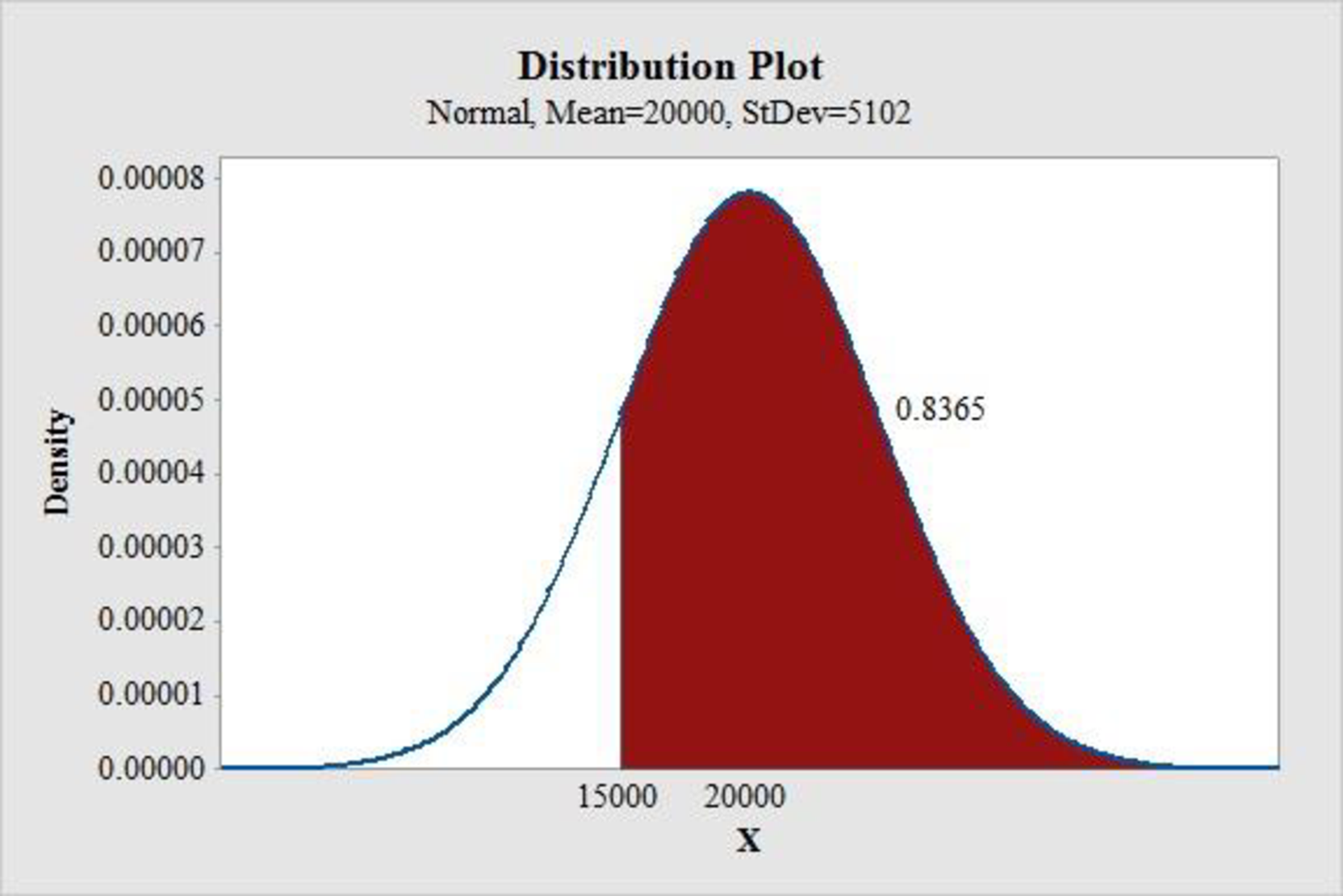
From the MINITAB output,
Thus, the probability of a stock-out for the order quantity of 15,000 units is 0.8365.
The probability of a stock-out for the order quantity of 18,000 units is
Software Procedure:
Step-by-step procedure to obtain the probability value using the MINITAB software:
- Choose Graph > Probability Distribution Plot
- Choose View Probability > OK.
- From Distribution, choose ‘Normal’ distribution.
- Enter the Mean as 20,000 and Standard deviation as 5,102.
- Click the Shaded Area tab.
- Choose X Value and Right Tail for the region of the curve to shade.
- Enter the X value as 18,000.
- Click OK.
Output using the MINITAB software is given below:
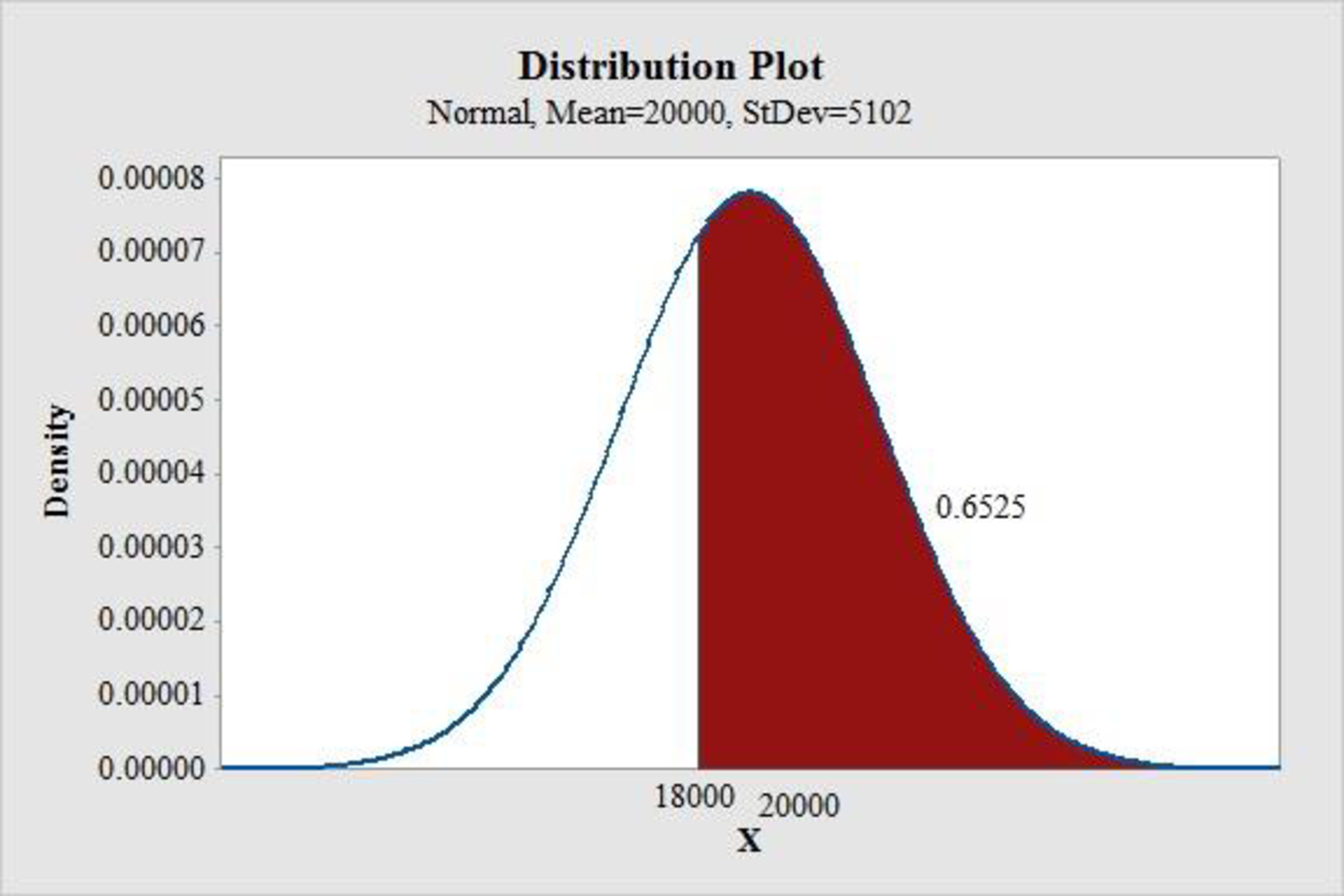
From the MINITAB output,
Thus, the probability of a stock-out for the order quantity of 18,000 units is 0.6525.
The probability of a stock-out for the order quantity of 24,000 units is
Software Procedure:
Step-by-step procedure to obtain the probability value using the MINITAB software:
- Choose Graph > Probability Distribution Plot
- Choose View Probability > OK.
- From Distribution, choose ‘Normal’ distribution.
- Enter the Mean as 20,000 and Standard deviation as 5,102.
- Click the Shaded Area tab.
- Choose X Value and Right Tail for the region of the curve to shade.
- Enter the X value as 24,000.
- Click OK.
Output using the MINITAB software is given below:
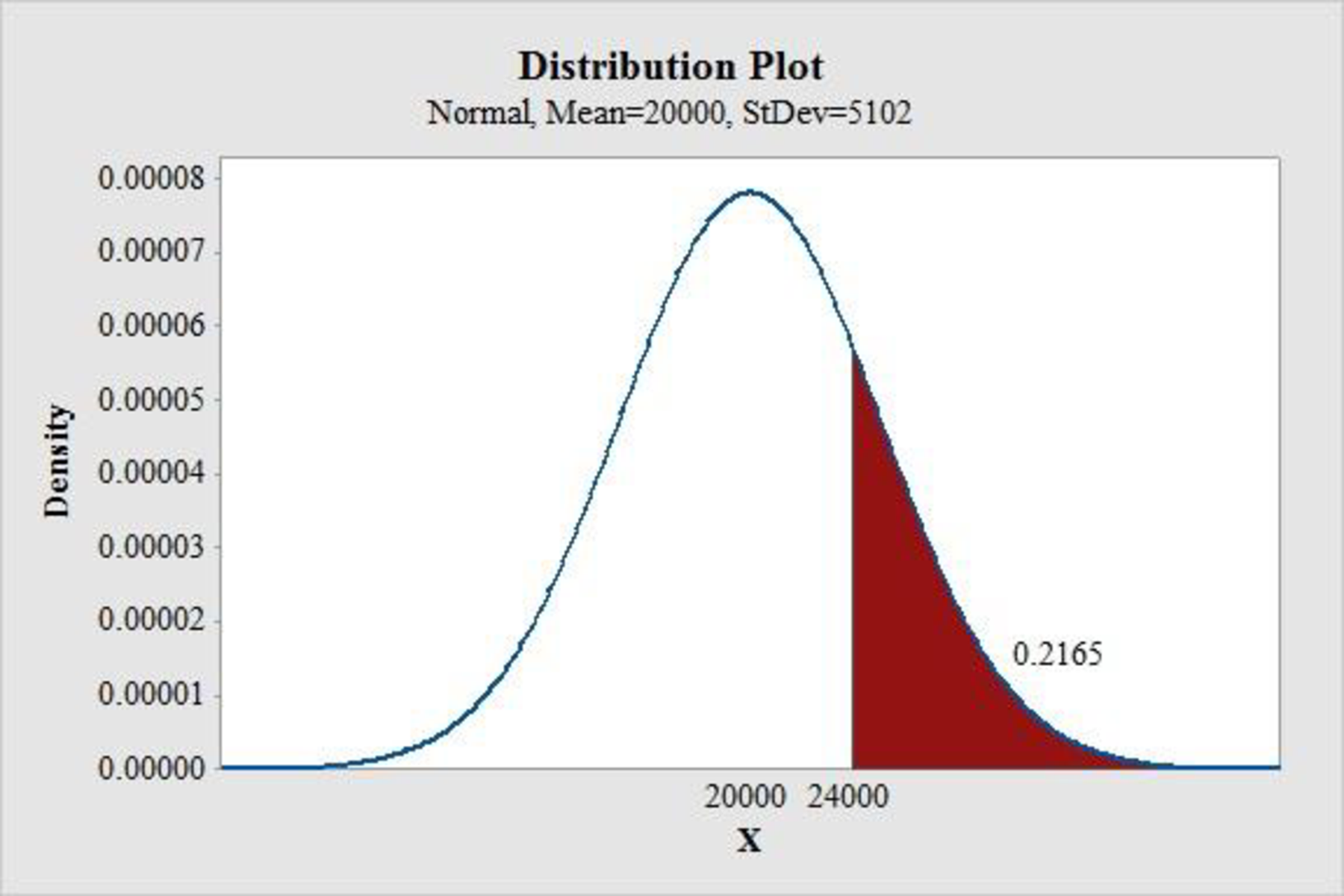
From the MINITAB output,
Thus, the probability of a stock-out for the order quantity of 24,000 units is 0.2165.
The probability of a stock-out for the order quantity of 28,000 units is
Software Procedure:
Step-by-step procedure to obtain the probability value using the MINITAB software:
- Choose Graph > Probability Distribution Plot
- Choose View Probability > OK.
- From Distribution, choose ‘Normal’ distribution.
- Enter the Mean as 20,000 and Standard deviation as 5,102.
- Click the Shaded Area tab.
- Choose X Value and Right Tail for the region of the curve to shade.
- Enter the X value as 28,000.
- Click OK.
Output using the MINITAB software is given below:
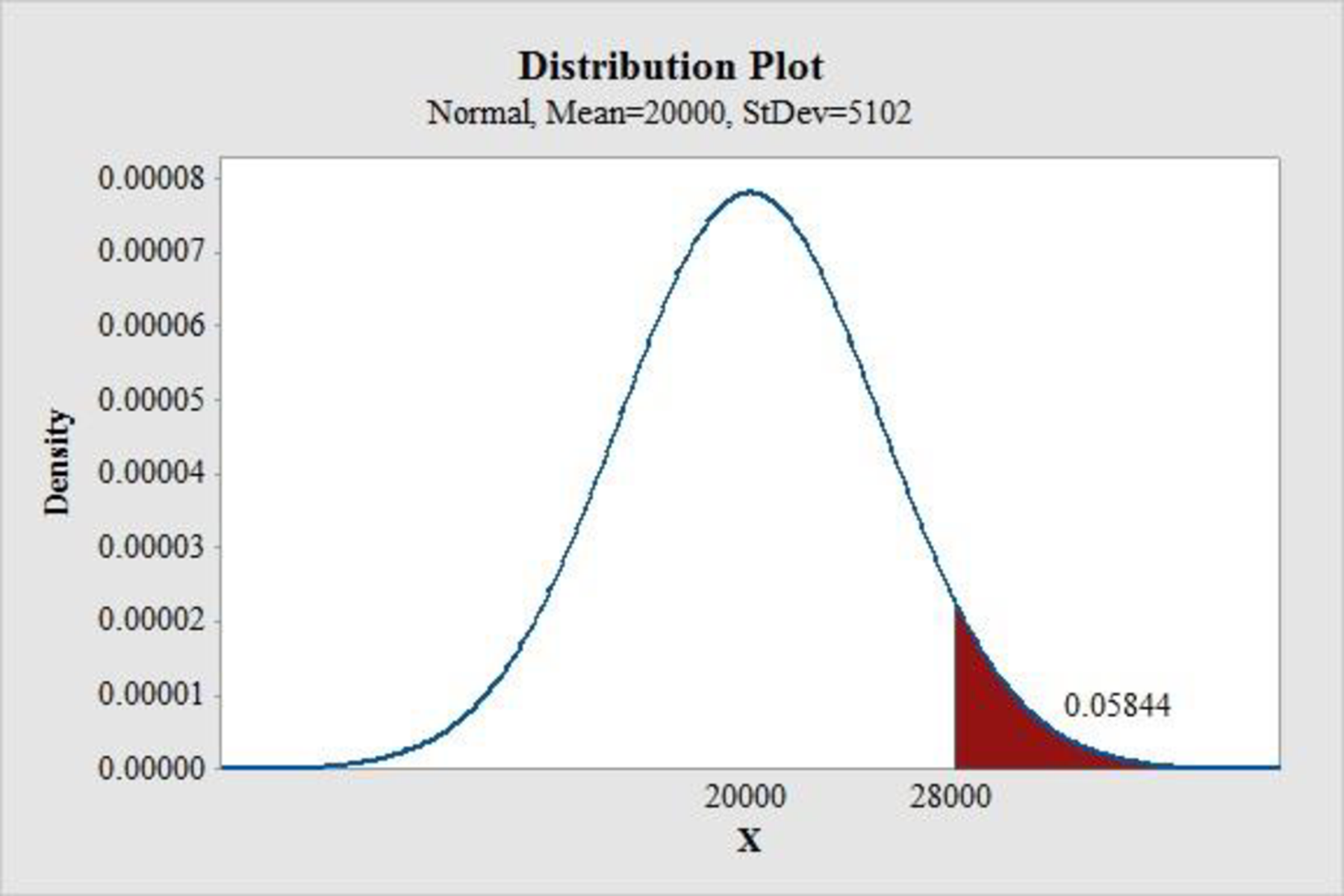
From the MINITAB output,
Thus, the probability of a stock-out for the order quantity of 28,000 units is 0.05844.
3.
Find the projected profit for the order quantities suggested by the management team under the three scenarios.
Answer to Problem 1CP
The projected profit for the order quantities are given below:
For an order quantity of 15,000 units:
| Unit sales | Total cost ($) | At $24 | At $5 | Profit($) |
| 10,000 | 240,000 | 240,000 | 25,000 | 25,000 |
| 20,000 | 240,000 | 360,000 | 0 | 120,000 |
| 30,000 | 240,000 | 360,000 | 0 | 120,000 |
For an order quantity of 18,000 units:
| Unit sales | Total cost ($) | At $24 | At $5 | Profit($) |
| 10,000 | 288,000 | 240,000 | 40,000 | –8,000 |
| 20,000 | 288,000 | 432,000 | 0 | 144,000 |
| 30,000 | 288,000 | 432,000 | 0 | 144,000 |
For an order quantity of 24,000 units:
| Unit sales | Total cost ($) | At $24 | At $5 | Profit($) |
| 10,000 | 384,000 | 240,000 | 70,000 | –74,000 |
| 20,000 | 384,000 | 480,000 | 20,000 | 116,000 |
| 30,000 | 384,000 | 576,000 | 0 | 192,000 |
For an order quantity of 28,000 units:
| Unit sales | Total cost ($) | At $24 | At $5 | Profit($) |
| 10,000 | 448,000 | 240,000 | 90,000 | –118,000 |
| 20,000 | 448,000 | 480,000 | 40,000 | 72,000 |
| 30,000 | 448,000 | 672,000 | 0 | 224,000 |
Explanation of Solution
Calculation:
The three scenarios under consideration are, worst case in which there is a sale of 10,000 units, most likely case in which there is a sale of 20,000 units and the best case in which there is a sale of 30,000 units.
The profit projections for the order quantities under three scenarios are computed using the following table:
For an order quantity of 15,000 units:
Total cost is obtained by multiplying the cost of a unit ($16) with the order quantity.
The income at $24 is obtained by multiplying $24 with the number of units sold.
For the unit sales more than 15, 000, the income at $24 is obtained by multiplying $24 with the order quantity 15,000 units.
The income at $5 is obtained by multiplying $5 with the number of surplus units (number of units sold–order quantity).
The income at $5 will be zero for the order quantities more than 15,000 units.
The profit is obtained as shown below:
Profit obtained for a sale of 10,000 units is,
| Unit sales | Total cost ($) | At $24 | At $5 | Profit($) |
| 10,000 | 240,000 | 240,000 | 25,000 | 25,000 |
| 20,000 | 240,000 | 360,000 | 0 | 120,000 |
| 30,000 | 240,000 | 360,000 | 0 | 120,000 |
Similarly, the profit projections are obtained and are given in the following tables:
For an order quantity of 18,000 units:
| Unit sales | Total cost ($) | At $24 | At $5 | Profit($) |
| 10,000 | 288,000 | 240,000 | 40,000 | –8,000 |
| 20,000 | 288,000 | 432,000 | 0 | 144,000 |
| 30,000 | 288,000 | 432,000 | 0 | 144,000 |
For an order quantity of 24,000 units:
| Unit sales | Total cost ($) | At $24 | At $5 | Profit($) |
| 10,000 | 384,000 | 240,000 | 70,000 | –74,000 |
| 20,000 | 384,000 | 480,000 | 20,000 | 116,000 |
| 30,000 | 384,000 | 576,000 | 0 | 192,000 |
For an order quantity of 28,000 units:
| Unit sales | Total cost ($) | At $24 | At $5 | Profit($) |
| 10,000 | 448,000 | 240,000 | 90,000 | –118,000 |
| 20,000 | 448,000 | 480,000 | 40,000 | 72,000 |
| 30,000 | 448,000 | 672,000 | 0 | 224,000 |
4.
Find quantity that would be ordered under the policy and the profit at three sales scenarios.
Answer to Problem 1CP
The quantity that would be ordered under the policy is 22,675.
The profit at three sales scenarios are given in the following table:
| Unit sales | Total cost ($) | At $24 | At $5 | Profit($) |
| 10,000 | 362,800 | 240,000 | 63,375 | –59,425 |
| 20,000 | 362,800 | 480,000 | 13,375 | 130,575 |
| 30,000 | 362,800 | 544,200 | 0 | 181,400 |
Explanation of Solution
Calculation:
The order quantity should have a 70% chance of meeting demand and only a 30% chance of any stock outs. That is the order quantity that cuts off an area of 0.70 in the lower tail of the normal curve for demand.
Software Procedure:
Step-by-step procedure to obtain the x value using the MINITAB software:
- Choose Graph > Probability Distribution Plot.
- Choose View Probability > OK.
- From Distribution, choose ‘Normal’ distribution.
- Enter the Mean as 20,000 and Standard deviation as 5,102.
- Click the Shaded Area tab.
- Choose Probability Value and left tail for the region of the curve to shade.
- Enter the Probability value as 0.70.
- Click OK.
Output using the MINITAB software is given below:
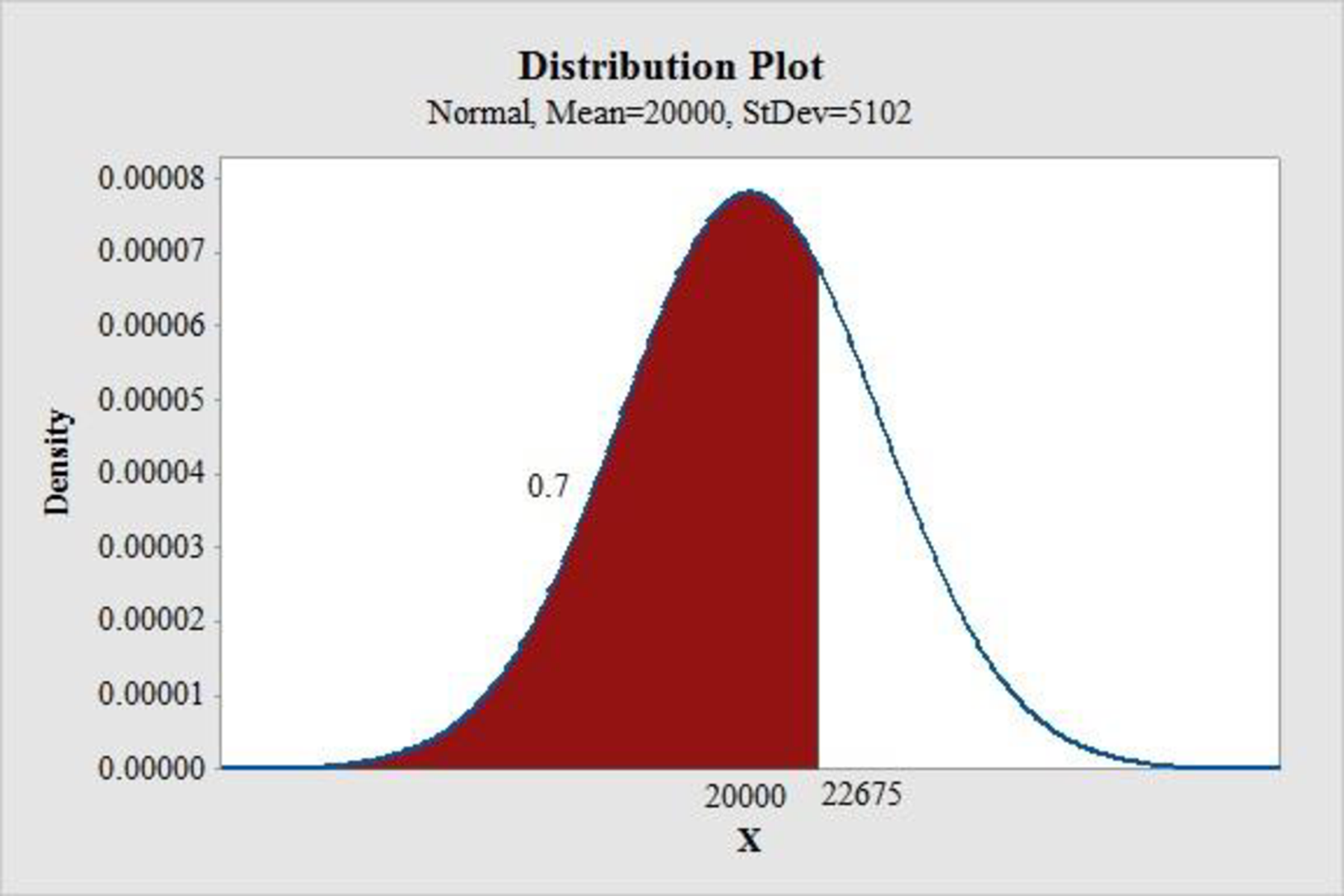
Thus, the quantity that would be ordered under the policy is 22,675.
The profit projections are obtained with the similar calculations made in part(c) for an order quantity of 22,675 units and is given in the following table:
| Unit sales | Total cost ($) | At $24 | At $5 | Profit($) |
| 10,000 | 362,800 | 240,000 | 63,375 | –59,425 |
| 20,000 | 362,800 | 480,000 | 13,375 | 130,575 |
| 30,000 | 362,800 | 544,200 | 0 | 181,400 |
5.
Provide the recommendation for an order quantity and note the associated profit projections and provide the rationale for the recommendation.
Explanation of Solution
A variety of recommendations are possible. From the three scenarios used in part (c) and (d) it is clear that an order quantity in the range 18,000 to 20,000 will be good to generate profit. Because the order quantities of more than 20,000 units generates a risk of loss and reduces the chance of generating good profits.
Want to see more full solutions like this?
Chapter 6 Solutions
EBK STATISTICS FOR BUSINESS & ECONOMICS
- der to complete the Case X T Civil Service Numerical Test Sec X T Casework Skills Practice Test Maseline Vaseline x + euauthoring.panpowered.com/DeliveryWeb/Civil Service Main/84589a48-6934-4b6e-a6e1-a5d75f559df9?transferToken-News NGSSON The table below shows the best price available for various items from 4 uniform suppliers. The prices do not include VAT (charged at 20%). Item Waterproof boots A1-Uniforms (£)Best Trade (£)Clothing Tech (£)Dress Right (£) 59.99 39.99 59.99 49.99 Trousers 9.89 9.98 9.99 11.99 Shirts 14.99 15.99 16.99 12.99 Hi-Vis vest 4.49 4.50 4.00 4.00 20.00 25.00 19.50 19.99 Hard hats A company needs to buy a set of 12 uniforms which includes 1 of each item. If the special offers are included which supplier is cheapest? OOO A1-Uniforms Best Trade Clothing Tech Q Search + ** 109 8 CO* F10 Home F11 F12 6arrow_forwardto complete the Case × T Civil Service Numerical Test Sec x T Casework Skills Practice Test + Vaseline euauthoring.panpowered.com/DeliveryWeb/Civil Service Main/84589a48-b934-4b6e-a6e1-a5d75f559df9?transferToken=MxNewOS NGFSPSZSMOMzuz The table below shows the best price available for various items from 4 uniform suppliers. The prices do not include VAT (charged at 20%). Item A1-Uniforms (£)Best Trade (£)Clothing Tech (£)Dress Right (£) Waterproof boots 59.99 39.99 59.99 49.99 Trousers 9.89 9.98 9.99 11.99 Shirts 14.99 15.99 16.99 12.99 Hi-Vis vest 4.49 4.50 4.00 4.00 20.00 25.00 19.50 19.99 Hard hats A company needs to buy a set of 12 uniforms which includes 1 of each item. If the special offers are included, which supplier is cheapest? O O O O A1-Uniforms Best Trade Clothing Tech Dress Right Q Search ENG L UK +0 F6 四吧 6 78 ㄓ F10 9% * CO 1 F12 34 Oarrow_forwardCritics review films out of 5 based on three attributes: the story, the special effects and the acting. The ratings of four critics for a film are collected in the table below.CriticSpecialStory rating Effects rating Acting rating Critic 14.44.34.5Critic 24.14.23.9Critic 33.943.4Critic 44.24.14.2Critic 1 also gave the film a rating for the Director's ability. If the average of Critic 1's ratings was 4.3 what rating did they give to the Director's ability?3.94.04.14.24.3arrow_forward
- Two measurements are made of some quantity. For the first measurement, the average is 74.4528, the RMS error is 6.7441, and the uncertainty of the mean is 0.9264. For the second one, the average is 76.8415, the standard deviation is 8.3348, and the uncertainty of the mean is 1.1448. The expected value is exactly 75. 13. Express the first measurement in public notation. 14. Is there a significant difference between the two measurements? 1 15. How does the first measurement compare with the expected value? 16. How does the second measurement compare with the expected value?arrow_forwardA hat contains slips of paper numbered 1 through 6. You draw two slips of paper at random from the hat,without replacing the first slip into the hat.(a) (5 points) Write out the sample space S for this experiment.(b) (5 points) Express the event E : {the sum of the numbers on the slips of paper is 4} as a subset of S.(c) (5 points) Find P(E)(d) (5 points) Let F = {the larger minus the smaller number is 0}. What is P(F )?(e) (5 points) Are E and F disjoint? Why or why not?(f) (5 points) Find P(E ∪ F )arrow_forwardIn addition to the in-school milk supplement program, the nurse would like to increase the use of daily vitamin supplements for the children by visiting homes and educating about the merits of vitamins. She believes that currently, about 50% of families with school-age children give the children a daily megavitamin. She would like to increase this to 70%. She plans a two-group study, where one group serves as a control and the other group receives her visits. How many families should she expect to visit to have 80% power of detecting this difference? Assume that drop-out rate is 5%.arrow_forward
- A recent survey of 400 americans asked whether or not parents do too much for their young adult children. The results of the survey are shown in the data file. a) Construct the frequency and relative frequency distributions. How many respondents felt that parents do too much for their adult children? What proportion of respondents felt that parents do too little for their adult children? b) Construct a pie chart. Summarize the findingsarrow_forwardThe average number of minutes Americans commute to work is 27.7 minutes (Sterling's Best Places, April 13, 2012). The average commute time in minutes for 48 cities are as follows: Click on the datafile logo to reference the data. DATA file Albuquerque 23.3 Jacksonville 26.2 Phoenix 28.3 Atlanta 28.3 Kansas City 23.4 Pittsburgh 25.0 Austin 24.6 Las Vegas 28.4 Portland 26.4 Baltimore 32.1 Little Rock 20.1 Providence 23.6 Boston 31.7 Los Angeles 32.2 Richmond 23.4 Charlotte 25.8 Louisville 21.4 Sacramento 25.8 Chicago 38.1 Memphis 23.8 Salt Lake City 20.2 Cincinnati 24.9 Miami 30.7 San Antonio 26.1 Cleveland 26.8 Milwaukee 24.8 San Diego 24.8 Columbus 23.4 Minneapolis 23.6 San Francisco 32.6 Dallas 28.5 Nashville 25.3 San Jose 28.5 Denver 28.1 New Orleans 31.7 Seattle 27.3 Detroit 29.3 New York 43.8 St. Louis 26.8 El Paso 24.4 Oklahoma City 22.0 Tucson 24.0 Fresno 23.0 Orlando 27.1 Tulsa 20.1 Indianapolis 24.8 Philadelphia 34.2 Washington, D.C. 32.8 a. What is the mean commute time for…arrow_forwardMorningstar tracks the total return for a large number of mutual funds. The following table shows the total return and the number of funds for four categories of mutual funds. Click on the datafile logo to reference the data. DATA file Type of Fund Domestic Equity Number of Funds Total Return (%) 9191 4.65 International Equity 2621 18.15 Hybrid 1419 2900 11.36 6.75 Specialty Stock a. Using the number of funds as weights, compute the weighted average total return for these mutual funds. (to 2 decimals) % b. Is there any difficulty associated with using the "number of funds" as the weights in computing the weighted average total return in part (a)? Discuss. What else might be used for weights? The input in the box below will not be graded, but may be reviewed and considered by your instructor. c. Suppose you invested $10,000 in this group of mutual funds and diversified the investment by placing $2000 in Domestic Equity funds, $4000 in International Equity funds, $3000 in Specialty Stock…arrow_forward
- The days to maturity for a sample of five money market funds are shown here. The dollar amounts invested in the funds are provided. Days to Maturity 20 Dollar Value ($ millions) 20 12 30 7 10 5 6 15 10 Use the weighted mean to determine the mean number of days to maturity for dollars invested in these five money market funds (to 1 decimal). daysarrow_forwardc. What are the first and third quartiles? First Quartiles (to 1 decimals) Third Quartiles (to 4 decimals) × ☑ Which companies spend the most money on advertising? Business Insider maintains a list of the top-spending companies. In 2014, Procter & Gamble spent more than any other company, a whopping $5 billion. In second place was Comcast, which spent $3.08 billion (Business Insider website, December 2014). The top 12 companies and the amount each spent on advertising in billions of dollars are as follows. Click on the datafile logo to reference the data. DATA file Company Procter & Gamble Comcast Advertising ($billions) $5.00 3.08 2.91 Company American Express General Motors Advertising ($billions) $2.19 2.15 ETET AT&T Ford Verizon L'Oreal 2.56 2.44 2.34 Toyota Fiat Chrysler Walt Disney Company J.P Morgan a. What is the mean amount spent on advertising? (to 2 decimals) 2.55 b. What is the median amount spent on advertising? (to 3 decimals) 2.09 1.97 1.96 1.88arrow_forwardMartinez Auto Supplies has retail stores located in eight cities in California. The price they charge for a particular product in each city are vary because of differing competitive conditions. For instance, the price they charge for a case of a popular brand of motor oil in each city follows. Also shown are the number of cases that Martinez Auto sold last quarter in each city. City Price ($) Sales (cases) Bakersfield 34.99 501 Los Angeles 38.99 1425 Modesto 36.00 294 Oakland 33.59 882 Sacramento 40.99 715 San Diego 38.59 1088 San Francisco 39.59 1644 San Jose 37.99 819 Compute the average sales price per case for this product during the last quarter? Round your answer to two decimal places.arrow_forward
 MATLAB: An Introduction with ApplicationsStatisticsISBN:9781119256830Author:Amos GilatPublisher:John Wiley & Sons Inc
MATLAB: An Introduction with ApplicationsStatisticsISBN:9781119256830Author:Amos GilatPublisher:John Wiley & Sons Inc Probability and Statistics for Engineering and th...StatisticsISBN:9781305251809Author:Jay L. DevorePublisher:Cengage Learning
Probability and Statistics for Engineering and th...StatisticsISBN:9781305251809Author:Jay L. DevorePublisher:Cengage Learning Statistics for The Behavioral Sciences (MindTap C...StatisticsISBN:9781305504912Author:Frederick J Gravetter, Larry B. WallnauPublisher:Cengage Learning
Statistics for The Behavioral Sciences (MindTap C...StatisticsISBN:9781305504912Author:Frederick J Gravetter, Larry B. WallnauPublisher:Cengage Learning Elementary Statistics: Picturing the World (7th E...StatisticsISBN:9780134683416Author:Ron Larson, Betsy FarberPublisher:PEARSON
Elementary Statistics: Picturing the World (7th E...StatisticsISBN:9780134683416Author:Ron Larson, Betsy FarberPublisher:PEARSON The Basic Practice of StatisticsStatisticsISBN:9781319042578Author:David S. Moore, William I. Notz, Michael A. FlignerPublisher:W. H. Freeman
The Basic Practice of StatisticsStatisticsISBN:9781319042578Author:David S. Moore, William I. Notz, Michael A. FlignerPublisher:W. H. Freeman Introduction to the Practice of StatisticsStatisticsISBN:9781319013387Author:David S. Moore, George P. McCabe, Bruce A. CraigPublisher:W. H. Freeman
Introduction to the Practice of StatisticsStatisticsISBN:9781319013387Author:David S. Moore, George P. McCabe, Bruce A. CraigPublisher:W. H. Freeman





